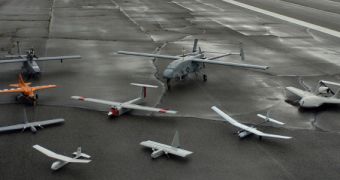Officials with the Pentagon have announced that the organization's research unit is already working on a program that will enable drones to operate together, supporting each other as they survey targets, intercept communications, or engage targets at all ranges. Using drone swarms could make supporting troops on the ground a lot easier and more efficient, representatives from the Pentagon say.
In order for this project to become reality, drones need to be able to share data and work together above the battlefield, while remaining under the control of a single person. Sharing control among multiple operators would prohibit the type of close-quarters, tight turns and other maneuvers that the Pentagon is interested in obtaining.
The new capability is being developed through the Collaborative Operations in Denied Environments (CODE) program, which will host a Proposers' Day to hear various proposals on this topic on April 11. The entire program is being managed by the US Defense Advanced Research Projects Agency (DARPA). “Autonomy and inter-platform collaboration” are the main goals of the CODE program.
DARPA experts have announced their intention to focus this project on developing four technology areas that will work together to enable seamless operations of multiple drones. The first is developing a single-drone flight autonomy capability, which will later be combined with a human-systems interface capable of allowing the commander to take charge of multiple drones.
Another critical aspect is creating the necessary software protocols for each individual drone in a team to cooperate with any other, and with all others at the same time. Lastly, an open-architecture scheme needs to be set up where each drone can pass information between itself and other drones, or directly to its human operator.
DARPA says that it expects future conflicts to have different traits than current ones, including a “higher level of threats, contested electromagnetic spectrum, and re-locatable targets.” The new drone system needs to be developed in a way that answers such situations preemptively, so it does not get caught off guard.
Another possible use for the new technology would be in smaller-scale drones, such as those that are issued to reconnaissance and patrol teams on the battlefield. These are hand-deployable unmanned aerial systems (UAS) of small dimensions, capable of flying unnoticed and collecting data over obstacles such as hills and walled-off towns.
Having the ability to fly multiple drones of this type in formation would enable operators in the field to continue to press their mission objectives even if one or more of the tiny aircraft are destroyed by the enemy, Space War reports.

 14 DAY TRIAL //
14 DAY TRIAL //